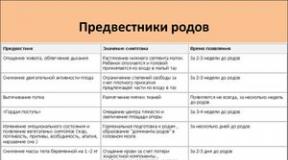The use of educational situations in the process of moral education of children of senior preschool age. methodological development (senior group) on the topic. Fundamentals of Islamic culture Methodology for the formation of personal norms
Ministry of General and Professional Education of the Sverdlovsk Region
State budgetary professional educational institution
Sverdlovsk region
"Kamyshlovsky Pedagogical College"

Kamyshlov, 2016
Collection of pedagogical situations aimed at developing ethical behavior / comp. E. Emelyanova - Kamyshlov: GBOU SPO "Kamyshlovsky Pedagogical College", 2016. 17 p.
Reviewer: Ustyantseva L.D. - teacher of pedagogical disciplines
The collection includes a number of pedagogical situations for working with students in grades 2-3, which are solved both in class and outside of class.
This collection can be used by students and can also be useful for primary school teachers and class teachers.
© GBOU SPO "Kamyshlovsky Pedagogical College"
1 section. “Pedagogical situations in the classroom” 6
Section 2 “Pedagogical situations outside the lesson” 10
Section 3 “Pedagogical situations intentionally created” 16
References 20
Explanatory note
We can talk about morality only when a person behaves morally due to internal motivation, when his own views and beliefs act as control. The development of such views and beliefs and the corresponding habits of behavior constitute the essence of moral education.
Based on the Federal State Educational Standard for Primary General Education, the concept of spiritual and moral development and upbringing of the personality of a Russian citizen, and the curriculum of an educational institution, a collection of pedagogical situations has been compiled aimed at developing the ethical behavior of younger schoolchildren.
Each new time poses new challenges for teachers. When raising children, we must turn their gaze to the good, the eternal, the good. Teachers are left alone with the monsters of the 21st century: depravity, cruelty, and the cult of destructive power. In these conditions, teachers must find moral strength, knowledge, wisdom, that pedagogical theory that will help to carry out the task of moral and civic education of schoolchildren, reveal its spiritual qualities, develop moral feelings, instill skills in the fight against evil, the ability to make the right choice, and moral self-determination.
Negative trends among young people continue to grow: indifference, selfishness, cynicism, unmotivated aggressiveness, disrespect for the state and institutions of power are spreading; The crime rate remains high, drug addiction and alcoholism are spreading among young people; The physical and mental condition of young people is deteriorating. Thanks to working with ethical behavior, the following value guidelines will develop: emotional attitude towards kindness, anger, goodwill, conflict, politeness.
Ethical behavior is an integral part of the moral education of children, which consists of fostering a culture of behavior at home, at school, in public places, and on the street. Ethical education includes: the study of moral norms as a support for the rules of behavior, the formation of concepts about the rules of behavior in various conditions, the development of skills and abilities of the moral and ethical qualities of an individual. Through ethics education, teachers teach children how to behave in a variety of settings.
Based on this concept, the following levels of ethical behavior are distinguished:
Level of maladjustment;
Identification level;
Level of individualization;
Level of socialization;
Level of integration.
A collection of assignments is a publication containing various works of one or more authors, as well as various materials.
This manual is addressed to primary school teachers. Depending on the educational goals, the teacher can use these pedagogical situations both in class and outside of class.
Target: selection and systematization of pedagogical situations aimed at developing the ethical education of primary schoolchildren.
This collection consists of 3 sections that can be used in any order:
1 section “Pedagogical situations in the lesson”, in which there are 15 pedagogical situations. Tasks may not be completed in order.
Section 2 “Pedagogical situations outside the lesson”, in which there are 15 pedagogical situations. Tasks may not be completed in order.
Section 3 “Pedagogical situations intentionally created”, in which there are 10 pedagogical situations. These pedagogical situations can be performed both in class and outside of class. Tasks may not be completed in order.
In total, the collection presents ... pedagogical situations.
Practical significance: for students to develop ethical education in younger schoolchildren both in extracurricular activities and during lessons. The teacher also uses the material to develop ethical behavior.
1 section. “Pedagogical situations in the classroom”
Situation 1. “Spoiled picture”
What's that noise? They immediately say:
- He drew in the picture...
- He ruined her!..
Yes, now I see: the boy is at the blackboard, at the picture that we just looked at in class. He looks up and is tensely silent. And he exhales sharply, hotly:
– I...I didn’t mean to, I accidentally...
The boy cried loudly...
Questions:

Situation 2.
The table you're sitting at
The bed you sleep in
Notebook, boots, pair of skis. 
Plate, fork, spoon, knife,
And every nail
And every house
And a loaf of bread -
All this was done by labor,
But it didn't fall from the sky...
(V. Livshits)
Questions:
Why should people's hands be looked at with respect and hope?
Is it possible to justify those people who break and spoil what others have created through hard work?
What do you think, what does someone who does not take care of their own or other people’s property think about?
Situation 3.
GRANDFATHER MAZAI AND THE HARES
Old Mazai chatted in the barn:
"In our swampy lowland
There would be five times more game, 
If only they didn't catch her with nets,
If only they didn't force her down.
Hares too - I feel sorry for them to the point of tears!
Only the spring waters will rush in,
And without that, they are dying by the hundreds,
No! not enough yet! men are running
They catch them, drown them, and beat them with hooks.
Where is their conscience?.. I'm just getting firewood
I went in a boat - there are a lot of them from the river
In the spring the flood comes to us, -
I go and catch them. The water is coming.
I see one small island -
The hares gathered on it in a crowd.
Then I arrived: their ears were chattering,
You can't move; I took one
He commanded the others: jump yourself!
My hares jumped - nothing!
The oblique team just sat down,
The entire island disappeared under water...
(N. Nekrasov)
Questions:
Why does Grandpa Mazai feel so sorry for the hares?
How does he relate to the nature around him?
Situation 4.
ABOUT THE HURRY MARTEN AND THE PATIENT TIT
The hasty Marten began to cut a silk sundress for summer. Blooper! All the silk was shredded and cut into shreds. And not like a sundress - a scarf cannot be sewn from these scraps.
The patient Tit began to cut an apron from canvas. He’ll figure it out here, he’ll figure it out there, he’ll move it here, he’ll move it there. She figured everything out, calculated everything, drew everything, then took up the scissors. It turned out to be a good apron. Not a single scrap was wasted.
Marten was amazed. He looks at the apron and is jealous:
– Where did you learn cutting and sewing, Sinitsa? From whom? 
– My grandmother taught me to sew.
- How did she teach you?
- Yes, very simple. She told me to remember five magic words.
- Measure seven times and cut once.
Questions:
Why did Titmouse get a good apron?
What does the proverb mean: “Measure seven times and cut once”?
Situation 5.
The teacher distributes primers to the children. One student silently returns the book to the teacher. The teacher, showing the ABC book to the children, asks:
– Why did Igor return the primer to me?
- It's torn.
– What needs to be done to make the primer pleasant and usable again?
“It needs to be repaired and treated with care.”
Questions:
Who thinks differently?
Who will advise Igor what he should have done?
Situation 10.
Several students play Battleship during class. . .
Since this is said to the whole class, it is necessary to sacrifice time from the lesson. I think the children will wait to see how the teacher will react to this insult, humiliation, and the uselessness of this subject. It is pointless to continue the lesson, since such statements cannot be left unanswered, because the situation in this lesson will only get worse.
Let's start like this:
Who else thinks so?
The children still raised their hands.
Would you like to agree with you, if I now PROVE to you that you need this subject, even if there are no entrance exams for this subject, but it provides something more than just the need to study those subjects that are considered mandatory. Then I will no longer see those who play “Battleship” and are not late from the dining room. Well, how do you like the agreement? I’m listening to you, do you agree?
Situation 11.
Several students were 15 minutes late for class.
The teacher asks: “Why are you late?”
Students (chewing buns as they go): “We were in the cafeteria.”
Questions:
Aren't you ashamed to take time away from the lesson?
Did you do the right thing? Why?
What should you do in this situation?
Situation 12.
The student tells the teacher: “I forgot to bring my notebook again (to do my homework, etc.).” How should the teacher respond to this?
Questions:
Do you think it's right to go to class without a notebook?
Why did you forget your notebook?
What should you do to not forget about your notebooks?
Situation 13.
The student came to class and sat down in his seat without saying hello to the teacher.
Questions:
Guys, did the student do the right thing? Why?
What should you do when you come to class?
Why are we doing this?
Situation 14.
At a literary reading lesson, children study the work of Charles Perrault “Puss in Boots”. After reading the first part of the work, the teacher and the children discuss it.
Questions:
Is it right that the youngest son underestimated his cat? Why?
What conclusion can be drawn?
Should you help your friends like the cat did? Why?
Situation 15.
During physical education class, children performed high jumps. One student fails to complete this exercise and therefore the other guys laughed at him. The child was offended and sat down on the bench.
Questions:
Guys, can we laugh at this? Why?
What should be done in this situation?
Will you do this in the future? Why?

Section 2 “Pedagogical situations outside the lesson”
Situation 1. “That’s impossible!”
Here we have a ready-made pedagogical situation. In fact, examples can be given endlessly, but we will analyze, for example, the situation with damage to stair railings, which can be called this: “This is impossible!” The teacher, going down the steps, accidentally noticed how a student was trying to cut the staircase railing with a penknife. Seeing the teacher, the boy ran away, forgetting even his jacket on the playground. The teacher told the child’s mother about everything that had happened, who simply did not believe that her son could do such a thing. She was convinced that her son was not to blame at all, and the other guys did this, because they live in an apartment with perfect order and beautiful furnishings, everyone in the family treats things and furniture with care and attention. When asked by his mother, the son admitted that he just wanted to try his knife in action. Imagine the boy’s surprise and indignation when the teacher suggested that he cut up a table or chair at home. He was simply sure that it was impossible to do this, because his father bought him this table. After reconstructing the picture of this situation, we can proceed to its analysis.
Questions:

Situation 2. "Broken"
Seven-year-old Vadim is crying in the yard.
-What are you talking about?
Rubbing his tears with his hands, he says that he gave the car to the boys to play with, but they broke it... Mom won’t be able to buy another one, she doesn’t have money...
Questions:
Did the boys do well? Why?
Guys, is it possible to break other people's toys?
There are three children in the family where Tanya is growing up. Their mother raises them alone. The girl is careful with her things, textbooks, notebooks... One day she saw her classmate Petya tearing blank sheets out of a notebook and making airplanes out of them.
- What are you doing? Why tear up a notebook, because it costs money?!
- I have a lot of them... I don’t mind... If I want, my father will buy more tomorrow...
Questions:
Is it possible to tear notebooks, because your father spends money on them, not you?
How should you treat your things?
How should you treat other people's things?
Why do you need to do this?
Situation 4. “We need to save paper!”
Children glue books: one cuts strips of paper, two glue them to the covers. Vova, having tried the strip on the book, discovered that it was longer than necessary. The boy casually throws the book and the strip to Masha, who has cut it.
- Why do you throw a book, you’ll tear it! – Masha says indignantly.
-Who cuts like that? You can't save paper, give me scissors, I'll cut it myself!
Questions:

Situation 5.
At the rally on May 9, 2 8th grade students stood on the guard of honor near the monument. Suddenly, a 2-3 grade student runs out of the crowd of students, runs up to the guards and begins to make faces.
Why did the student do this? Did he do the right thing?
How should one behave at such events?
What advice should you give to this student?
Situation 6.
The entire 3rd grade goes to the cafeteria and wash their hands together before eating. One student, without washing his hands, runs to sit at the table. The teacher asks:
Petya, why didn’t you wash your hands before eating?
“And I never wash my hands before eating,” says Petya.
Why? - asks the teacher.
Why? They will still be dirty,” said Petya.
Questions:

Situation 7.
The teacher, walking along the school corridor, noticed how a couple of boys from the 3rd grade were tearing off leaves from flowers that were standing on the windowsill.
Questions:
Guys, is it possible to spoil plants?
Do you do the same at home?
Is it possible to spoil someone else's work?
How should we relate to the beauty of nature? Why?
Situation 8.
In the morning, upon arriving at school, on the threshold at the entrance, the teacher ran into her students Sasha and Dima. Dima quickly said hello and slipped ahead of the teacher through the door. Sasha, on the contrary, opened the door for the teacher, said hello and let her go forward.
Questions:
Which boy did the right thing and why?
What did Dima observe?
What other rules of etiquette do you know?
Are you following them?
What advice can you give to boys?
Situation 9.
During class breaks, all the children play in the corridor. Oleg and Vika collide while running and run into each other. Vika comes up to the teacher crying and says that Oleg hit her.
Questions:
Did Vika do the right thing? Why?
What should you do in this situation?
What other rules of conduct do you know?
Situation 10.
- Shame on you! - the class teacher reproaches the fourth grader, whom the girl hit with a book and who wanted to answer her in kind, - you’re a man! “Let her not hurt herself,” the “guilty one” mutters in response. “It’s not nice to fight with a girl.” - Why is she the first to climb... - He’s his again! - the teacher laments - She hit, but what am I... - And you step back, be a knight! - What else! - the boy raises his surprised eyes at the teacher, - she’s fighting, but what am I... - Yes, you finally understand! – the teacher is indignant... The boy leaves the teacher’s room without becoming a “knight” and without understanding why the class teacher scolded him. “Don’t let her climb in,” he says, opening the door and wiping away tears with his sleeve.
Questions:
Why did the boy never become a “knight”?
Did he do the right thing and why?
What should the boy do? To a girl?
How should you behave towards girls and boys?
Situation 11.
The entire 3rd grade is going on a hike for the whole day. All the way, the girls diligently carry their heavy bags, and the boys run happily next to them, not even trying to help the girls.
Questions:
Are the boys doing the right thing?
What should boys and girls do?
How should you behave on a hike? Why?
Situation 12.
Competitions are held in the basketball section. They start throwing the ball and laughing at the boy who missed the hoop and as a result the team lost.
Questions:
Guys, is it possible to do this?
What should be done in this situation?
Let's name the rules of behavior with the ball?
Situation 13.
One day, the 3rd grade boys and their teacher went on an excursion to the museum. The guys were very interested, and they listened carefully to the guide and looked at the exhibits. But a couple of boys from their class did not listen to the guide and ran from one exhibit to another, loudly discussing them and laughing.
Questions:
What did the boys do? Why?
How should you behave in a museum? Why?
What rules of conduct in public places do you know?
Situation 14.
Children of 2nd grade together with their teacher planted flowers in the school plot. As soon as the flowers began to sprout, the girls were very happy, and then the boys came and trampled them.
Questions:
Did the boys do the right thing?
Is it possible to spoil flowers?
How should we treat nature?
Can they help the girls? How?
Situation 15.
At the drawing circle, the children had to draw the Russian flag. All the guys who go to the club got to work. One of the students sat frowning without starting to work.
Why didn’t you start work? - asked the teacher.
Because I don’t like our country, I want to draw the flag of another country,” the student answered.
Questions:

Section 3 “Pedagogical situations intentionally created”
Situation 1.
The teacher asks pre-prepared students to come to the board and asks each pair to make bird feeders. The first pair of children happily begin to make the feeder, and the second pair of students say:
Questions:
Is it right that the guys refused to make feeders? Why?
Why do we need to feed birds?
What else can we do for birds besides feeders?
Situation 2.
Pre-prepared children read the work “Fedorino’s Grief.” Then there is a discussion with the class.
Questions:

Situation 3.
During a relay race in a physical education lesson, one of the students lost, as a result of which he, offended, sits on the bench and sits there until the end of the lesson.
The teacher asks: “Why didn’t you continue playing with the guys?
“I can’t do it, I won’t play sports,” the student answers.
Questions:
Why doesn't the boy want to play sports?
Is it necessary to play sports? Why?
What can we advise a boy to develop a sports spirit?
Situation 4.
During class time, the teacher asks the students in what years the Great Patriotic War took place. Most of the class raises their hands and answers the question; the remaining children sit without raising their hands. The teacher asks one of them.
Don't you know when the war was?
No, it was a long time ago and I’m not interested in it,” one of the students answers.
Questions:
Guys, is it right that the boy is not a patriot of the country? Why?
What can you do to develop a sense of patriotism?
What can we advise the boy?
Should you love your country? Why?
Why should we be patriots?
Situation 5.
A pair of students read part of the work expressively and discuss it.
Look at your hands, my friend... Look, my friend, at your hands, look at them with respect and hope. After all, everything that surrounds you, everything that has been built, erected, mined in the world - the table at which you sit, and the desk in the classroom where you study, and the window through which you look at the white light, and the roof above your head, and everything you are wearing, and the page on which these words are printed, and the bread, without which you cannot live a day - everything, absolutely everything was made by human hands. They are controlled by pen and hammer. They hold the steering wheels of ships and the steering wheels of cars, shovels and microscopes. They are able to carefully place a piece of sugar in your cup of tea and a heavy brick in the foundation of a new house, extract a pearl from the depths of the sea and a thorn from your finger. Both a baby's rattle and a soldier's rifle can be handled by human hands. They can accurately throw the ball into a basketball basket and a rocket to the moon. 
Questions:
What is this talking about?
Is work important for a person? Why?
Should we protect the work of others?
Do you like to work? How do you work?
Situation 6.
A 4th grade student grossly violates discipline. After conversations with him, the class teacher and school administration assure that this will not happen again. But when you leave the classroom door, everything starts all over again. This behavior has been going on for quite some time...
Questions:
Is the student behaving correctly? Why?
Why do you think he is breaking discipline again?
How should you behave at school? Why?
What should you advise the boy?
Situation 7.
One day a teacher went on a hike with 4th grade students. The teacher checked everything as expected, but after walking 500 m, he decided to check again: at Olya’s. It turned out to be a heavy backpack (she took 4 kg of potatoes), it “cut” her shoulders. After consulting, the guys decided to give the potatoes to the boy who had the lightest backpack. But this boy, Vova, immediately and sharply refused. The boys were unanimously indignant at his refusal, then Vova ran as fast as he could, two boys ran after him, but did not catch up, and he returned home. We took his backpack and moved on. We relaxed, had fun...
Questions:
Did Vova do the right thing? Why?
Do you need to help your comrades? For what?
Do you like to help? Who are you helping?
Situation 8.
The teacher asks each of the students to write down their moral qualities, before explaining what morality and moral qualities are. Then comes the discussion.
Questions:

Situation 9.
During recess, two 3rd grade students decided to read a book with fairy tales. Tanya was the first to take the book, Olya also wanted to read the same book. Olya approached Tanya’s desk:
Tanya, give me this book,” Olya asked. 
No, I won’t give it to you, I took it first,” Tanya answered.
If you don’t give me the book, I’ll take your pen,” Olya said.
Questions:
Guys, what can you say about girls?
Is it good to be greedy? Why?
What should each of the girls do?
Do you like to be greedy? Why?
How should you be towards your friends? For adults?
Situation 10.
A 3rd grade teacher and her students planted flowers in the school plot.
After class, one of the students gives the teacher one of the flowers they planted today.
Why did you pick the flowers that the girls planted today? - asked the teacher.
“I wanted to please you,” the student answered guiltily.
Thank you, but don’t do that again,” the teacher replied.
Questions:

References
- Morozova I.O. Activities of the class teacher in shaping the moral behavior of younger schoolchildren. Smolensk, 2001. URL: http://www.e-ng.ru/pedagogika/deyatelnost_klassnogo_rukovoditelya_po.html
The concept of spiritual and moral development and education of the personality of a citizen of Russia / Danilyuk A.Ya., Kondakov A.M., Tishkov V.A. - 2009. - p.5
Moral education of children in a modern primary school. URL: http://diplomba.ru/work/100466
Tasks and pedagogical situations: A manual for pedagogical students. Institute and teachers / V. L. Omelyanenko; L. Ts. Vovk, S. V. Omelyanenko - M.: Education, 1993.
Tambovkina T.I. Pedagogical situations // Primary school. 2006. No. 16
Godnik S.M., Spirin L.F., Frumkin M.L. and others. Pedagogical situations in the education of schoolchildren. Voronezh: VSU Publishing House, 1985.
I.V. Bagramyan, Moscow
The path of a person growing up is quite thorny. For a child, the first school of life is his family, which represents the whole world. In a family, a child learns to love, endure, rejoice, sympathize and many other important feelings. In the context of a family, an emotional and moral experience unique to it develops: beliefs and ideals, assessments and value orientations, attitudes towards people around them and activities. The priority in raising a child belongs to the family (M.I. Rosenova, 2011, 2015).
Let's declutter
Much has been written about how important it is to be able to let go and complete the old and outdated. Otherwise, they say, the new one will not come (the place is occupied), and there will be no energy. Why do we nod when reading such articles that motivate us to clean, but everything still remains in its place? We find thousands of reasons to put aside what we have put aside and throw it away. Or don’t start clearing out rubble and storage rooms at all. And we already habitually scold ourselves: “I’m completely cluttered, I need to pull myself together.”
Being able to easily and confidently throw away unnecessary things becomes a mandatory program for a “good housewife”. And often - a source of another neurosis for those who for some reason cannot do this. After all, the less we do “right” - and the better we can hear ourselves, the happier we live. And the more correct it is for us. So, let’s figure out whether it’s really necessary for you personally to declutter.
The art of communicating with parents

Parents often love to teach their children, even when they are old enough. They interfere in their personal lives, advise, condemn... It gets to the point that children do not want to see their parents because they are tired of their moral teachings.
What to do?
Accepting flaws. Children must understand that it will not be possible to re-educate their parents; they will not change, no matter how much you want them to. Once you accept their shortcomings, it will be easier for you to communicate with them. You will simply stop expecting a different relationship than you had before.
How to prevent cheating

When people start a family, no one, with rare exceptions, even thinks about starting relationships on the side. And yet, according to statistics, families most often break up precisely because of infidelity. Approximately half of men and women cheat on their partners within a legal relationship. In short, the number of faithful and unfaithful people is distributed 50 to 50.
Before we talk about how to protect a marriage from cheating, it is important to understand
Moral education of children.
Conversation on the topic: “What is friendship?”
Target: Clarify and generalize children’s ideas about friendship; teach to understand and evaluate the actions of heroes of literary works (E. Koshevaya “My Son”, V. Oseeva “Before the First Rain”) and their comrades.
Progress of the conversation
The guys have already read and told you many times about good friends and comrades. The adults talked about the need to be friends with each other. What kind of children do we call good friends?
The teacher asks several people. If children call specific children by name, then ask why they can be considered good friends.
Summarize the answers: “Children who play together, study, work together, help each other, take care of each other, know how to give in to each other, etc. can be called good friends.
Questions after reading
– What can you call Oleg and Grisha?
– Why can they be called friends?
– Why can Oleg be called a good friend?
– Tell us about how you make friends in kindergarten and at home?
During the conversation, the teacher helps children correctly evaluate the facts,
actions, expresses his attitude towards them.
It's called "Before the First Rain". Think about it, girls, oh
whom the story says are good friends or
friends.
Questions after reading
– Why did the teacher say: “It’s clear your friendship has reached
first rain!"
– Can Misha be called a good friend? Why
It is forbidden?
– What should Masha have done?
Having approved the children’s correct answers, the teacher talks about the need to always follow the rule of behavior: “Always help a friend, always help a friend.”
help out."
Conversation on the topic: “What is a friend?”
Target: Summarize and consolidate children’s ideas about friendship; give the idea that friends do not leave a friend in trouble; show the attractiveness of friendships.
Progress of the conversation
Guys, now I’ll read you A. Mitt’s story “The Ball in the Window,” and then we’ll talk about the children mentioned in the story.
Questions after reading
– What did Kolya see in the window?
-Where did the ball come from?
- Why did the guys bring Kolya a ball?
– What can you call these guys?
-What are these guys like?
– Why can they be called good friends?
– Was Kolya pleased that his friends took care of him and didn’t abandon him?
is he in trouble?
– Tell us how you take care of your friends, how you help
Them.
– How do people treat their good friends?
When assessing and summarizing children’s answers, note that adults and
children love good friends. It is very pleasant to be friends with them.
When people are friends and help each other, life is easier for them
and work.
You can tell children that the ability to be friends is
good quality. That's why people call the streets and squares of cities, cinemas and other institutions with the word "Friendship".
You can remember the proverb “Friendship is more valuable than money” and together with
explain its concept to children.
Conversation on the topic: "Sensitivity"
Target: Teach children to compare positive and negative actions and evaluate them; understand the motives of children’s actions and the need to comply with norms of behavior; give an idea of sensitivity and the need for a caring, sensitive attitude towards your peers; introduce a new word into the children’s dictionary – “sensitivity”; lead a rule of behavior - “Don’t wait to be asked for help, you need to see for yourself who needs help.”
Progress of the conversation
Guys, today I will read you two stories - “In the Garden” by E. Kosheva and “Blue Leaves” by V. Oseeva. Listen to them carefully, and then tell me which of the children you liked, Oleg or Katya?
Questions after reading
– Which of the children did you like?
– Why did you like Oleg?
– What can you call Oleg? What is he like?
Summarize children's answers, give an idea of sensitivity. "Oleg
kind, caring, attentive. Grisha didn’t ask him for anything,
Oleg himself noticed that it was difficult for his friend and took care of him. That's why
Oleg can also be called sensitive. A sensitive person does not wait for
he will be asked for help, and he himself offers his help.
– Do you think Grisha was pleased that Oleg took care of
him?
– Was Oleg pleased? How does the book say this?
Conclude that good deeds
Everyone is always pleased.
- Why didn’t you like Katya?
– What should Katya have done? Why?
– Was it pleasant for Lena to ask Katya to give her a pencil?
– Why do you need to take care of your friends and help them?
After summarizing the children’s answers, draw a conclusion about the need
always be kind, caring, sensitive, helpful
peers, without expecting a request for help,
help so that peers are not offended.
Introduce the rule: “Don’t wait to be asked for
help, learn to see for yourself who needs help."
Remember guys this rule and always follow it. Now we will go for a walk and learn how to follow this rule in games.
Note: During the walk, the outdoor game “Trap” and “Give me a hand” is played.
Conversation on the topic: "Goodwill"
Target: To consolidate and generalize children’s ideas about the need
sensitive, friendly attitude towards comrades; remind
rules of conduct: “Always help a friend, always help out a friend; don’t
wait until they ask you for help, you need to see for yourself who needs help; consolidate the terms “kind” and “sensitive” in the children’s vocabulary.
Progress of the conversation
Guys, today I will once again read to you A. Mitt’s story “The Ball in
window." Listen to him carefully.
Questions after reading
– What can you call the children who brought the ball?
What are they?
Summarize the children’s answers: “Yes, these children can be
call them good friends, kind, caring, sensitive, etc.
- Why can they be called that?
Summarize the children’s answers: “The children took care of their friend, brought him a ball and showed it in the window to amuse and please him. Kolya did not ask for this, but the children themselves figured out to please their friend. Therefore, they can be called sensitive, caring, kind comrades.”
– Was Kolya pleased that his comrades had not forgotten about him?
– How does the book say this?
If the children don’t remember, you can read the passage. Give to children
speak out, make a generalization: “Children or adults always have
It’s very pleasant and joyful if they are shown sensitivity and kindness.
Sensitivity is behavior when children or adults do good to people, care about others, help other people, do not wait for them to
They ask for it, but they help themselves. We've already talked about this,
when we read the stories “My Son” and “Blue Leaves”.
Now I will read you another story. It's called "Visitela"
wrote a story by V. Oseev. Listen to the story and then
tell me whether Musya was sensitive to Valya.
Questions after reading
– How did Musya react to Valya?
– What can you call it? What is she like? Why?
– What should Musa have done?
– What would you do if you came to see a sick friend? How would you help him? Tell me.
Guys, remember, I instilled behaviors that must be followed,
To be a good, empathetic friend.
Note: You can play a game during a walk or in the evening
dramatization of the fairy tale "The Cat, the Rooster and the Fox."
Conversation on the topic: "Sensitivity and modesty. How they differ"
Purpose: To summarize and reinforce children’s ideas about sensitivity and modesty; develop children’s ability to differentiate moral concepts and evaluate the actions of heroes of literary works - S. Baruzdin “Navy Seal”.
Progress of the conversation
Guys, today I will read you a familiar story “Navy Seal”, and you listen to it carefully.
Questions after reading
– Who did you like in this story? Why?
– How did Svetlana act?
– What can you call it? What is she like?
– Why can she be called a kind, resourceful, sensitive girl?
– What is sensitivity?
Summarize the children’s answers: “Sensitivity is behavior when children and adults do good to people, care about others, help people even when they are not asked for it, but when they see that people need help.”
If children call Svetlana modest, you need to confirm this, and
after the children answer about what sensitivity is, say: “You
they correctly called Svetlana modest because she saved a life
sailor, but didn’t tell anyone about it, didn’t brag.” If the children don’t
indicate modesty among Svetlana’s moral traits, then ask
children: “Can Svetlana be called modest and why?”
– What is modesty?
Summarize the children’s answers: “Modesty is behavior when
children and adults do well, but do not brag about it,
because boasting is not nice, not good. Therefore there is no need
talk about yourself: “I’m good”, “I did well”, but you need to be able to
wait for others to praise you."
– Sensitivity and modesty – the same thing or different?
Summarizing the children's answers, note that being sensitive
good and being modest is also good.
But these character traits are different: sensitivity is doing good to people, caring, helping others, and modesty is the ability to restrain yourself, although you want to say that you are good, this means not bragging.
And now I’ll read you a new story, “Colin’s Dad.” It was written by Gorskaya. The teacher reads the story. After reading, do not ask questions. If children want to say something, give them the opportunity to speak out.
Conversation on the topic: "Truthfulness"
Target: To generalize and consolidate children’s ideas about truthfulness. Show the attractiveness of truthfulness as a norm of behavior. Cultivate a negative attitude towards deception.
Progress of the conversation
Guys, we have already talked many times about what friendship and sensitivity are. Kindness, modesty. And today we will talk about another important quality of a person - truthfulness. But first, listen to V. Oseeva’s story “What’s easier?”
Questions after reading
– Which of the boys did you like best? Why?
– What can you call a boy who told his mother the truth? What is he like?
– What is truthfulness?
Summarize the children’s answers: “Truthfulness is such behavior
person, when adults and children always tell the truth, never
do not deceive, tell the truth even when you say it
unpleasant, difficult."
– Why do you need to be truthful? Why you can't cheat
people?
– How do you feel about people who always tell the truth?
Summarize the children's answers. Explain to children what is needed
always tell the truth, always be truthful. This
beautiful and even very good. They love truthful people. Children and adults are pleased and joyful when they are told the truth. You can quote the proverb: “Truth is brighter than the sun. Truth is clearer than the clear sky.” Cheating is not nice, it’s not good, and it’s unpleasant for people. They feel offended when they are deceived. Cheating and lying can lead to trouble.
I’ll now read you L. Tolstoy’s story “Cow”. Listen to him carefully, and then tell me why the misfortune happened in the peasant family.
Questions after reading
– Why did trouble happen in this family?
– What should Misha have done?
Conclude: the trouble happened because Misha did not have the courage to tell the truth. If he had not gotten scared and thrown the glass into the tub, the cow would have remained alive.
You must always boldly tell the truth, even when it is difficult and unpleasant to say.
Conversation on the topic: "Sensitivity and truthfulness"
Target: Summarize and consolidate children's ideas
about the need for a friendly, sensitive attitude towards people
(to elders, peers, kids); show the relationship and
features of such moral concepts as sensitivity and truthfulness;
help children understand the experience of their behavior and generalize it.
Progress of the conversation
- Guys, what holidays did our whole country and we celebrate recently?
– Remember how you congratulated your parents on these
holidays.
What gifts did you give them? How were they presented? What
did they say? Were your parents pleased that their children
congratulations on the holiday?
– What do you think was the best, the most
a nice gift for moms and dads?
– How to behave to bring joy
parents, not to upset them?
Make a generalization about how to behave and why. In the process of generalization, note that parents and other family members must be treated with care and sensitivity, and one must not deceive them.
– What do you think sensitivity is?
– What is truthfulness?
– Are sensitivity and truthfulness the same or different qualities? Tell children that these are different qualities. Sensitivity is a behavior when people care about others and help each other, and truthfulness is a behavior when people always tell the truth and do not deceive others. This means that sensitivity and truthfulness are different qualities. These qualities are the most important in a person and they need to be cultivated in oneself from childhood.
Conversation on the topic: "Modesty"
Target: To generalize and consolidate the signs of the concept of “modesty” - a modest person does good things, but does not brag, knows how to restrain himself;
clarify children's knowledge about the need and meaning of modesty
behavior; help children understand their behavior in light of this
moral norm; cultivate a positive attitude towards
modesty as a norm of behavior.
Progress of the conversation
Guys, we have already talked about modesty many times, read
stories about humble people, both adults and children.
– Remember what stories and about whom we read. What is it called
a story about Svetlana, who saved the life of a sailor? Who wrote this
story?
– Why can Svetlana be called modest? How else can it be
call (sensitive, resourceful, courageous). Why?
– Modesty and sensitivity are the same thing or
miscellaneous?
– What is the name of the story about Kolya and his dad? Who
wrote this story?
– Why can Kolya and his dad be called modest?
– What modest person have we read about yet? (S. Marshak “The Story of an Unknown Hero”). Why didn't anyone know the hero's name? Why did he remain unknown?
– What is modesty? Modesty is the behavior of a person when he does good, but does not brag about it, and knows how to restrain himself. He doesn’t say: “It’s me,” “I did better,” although sometimes I want to say this. Bragging is ugly, not good. It's unpleasant for other people. They don't like immodest people or braggarts. You will understand this when you and I read V. Oseeva’s story “The Hare Hat.”
Questions after reading
– Which of you wears a “bunny hat”?
– How should you behave so that your peers love you and play with you?
Summarize the children's statements.
Game and problem situations aimed at children’s assimilation of social norms and values accepted in society
Olga Vasilievna Yakovleva, teacher, School No. 842, MoscowJob description: I offer you game and problem situations for children of senior preschool age (5-7 years). This material will be of interest to educators working with children of senior preschool age and parents. It is aimed at the child’s assimilation of social norms and values accepted in society, the development of moral and moral qualities.
Target
Children’s assimilation of social norms and values accepted in society through play and problem situations.
Tasks
Teach children to see the moral side of perceived actions and events, to understand their essence.
To give an idea of the moral side of human relations, based on the creation of game and problem situations.
Develop the ability to reasonably evaluate your own actions and the actions of other people.
To develop moral and moral qualities.
Game situations
Polite requestTarget: Introducing children to forms of expressing requests addressed to an older stranger, an older relative, as well as a peer in different situations: at home, on the street, in public places.
1.Let's play children's store. Sveta is a seller, and other children are buyers. Let's lay out the toys on the "counter". (Each child chooses a purchase for himself and turns to the seller, and he politely answers him. In addition to the words of request, children should remember the words of gratitude and feedback on them - “please.”)
2.You are in an unfamiliar city. You need to go to the zoo, but you don't know the way. A passer-by is walking towards you. Let it be Vanya. Vika, go up to a passerby and ask him for directions to the zoo. How will you do it?
3.Mom told me to come home at 3 o’clock. But you don't have a watch. You will have to turn to someone senior. How will you do this?
4. Think of cases in which it is necessary to use words of request. Make sure that you and your friends never forget - neither at home, nor on the street, nor in kindergarten, nor in the store - to use them.

About compliance
Target: Explain to children how important it is in games and in serious matters not to be rude and to give in to each other.
1. Maxim and Yulia, you want to play checkers. Try to decide whose move will be first.
2. Let Dima be Uncle Kolya, and Olya and Lena his nieces. Uncle Kolya came to visit them. He brought one big starfish. Olya and Lena must accept the gift, but not quarrel. Let's listen to the conversation and see how the children behave.
3. We all want to look at the funny little puppy. Let's do this without crowding, giving in to each other.
4. The teacher brought a book with pictures. Seryozha, give way to Katya. Let her look at the book first. Katya, thank Seryozha. Or maybe we should look at the book together?

Comfort
Target: Combine empathy with verbal expressions of sympathy, introduce words of consolation into the child’s active vocabulary.
1. Let's find words of consolation (the task is given in pairs).
2.Masha pinched her finger. She's in pain. Comfort her.
3. The baby hurt himself and cried. Have pity on him.
4. Vanya broke the car that was given to him for his birthday. He was very upset. Think about how to help Vanya.
5.Let's play in the hospital. Doll Katya is sick. The nurse gave her an injection. Katya is in pain. Have pity on her.

Addressing an adult
Target: Strengthen the appeal to an adult by name and patronymic, combine direct appeal with an expression of joy.
1. Misha, what is your middle name? So, you will be Mikhail Sergeevich - Colin's neighbor. Kolya, imagine that you meet your adult neighbor at the entrance and want to show him your new car. How will you talk? Both of you must be polite.
2. Let Olya be a children's doctor - Olga Alekseevna, and Masha come to see her. Talk to each other.
3. Let Kolya be Nikolai Petrovich, Seryozha’s father. And you, Vitya, came to visit Seryozha. You must contact Nikolai Petrovich and ask him to help you and Seryozha understand the instructions for the designer.
Problem situations
1.If you accidentally pushed someone or touched someone with your hand. Your actions. ("Sorry, I accidentally hurt you. Sorry, I didn't mean to.")
2. Lena came dressed up, she wanted everyone to notice it right away, and from the threshold she said loudly: “Look how beautiful I am, what a dress I have, what shoes, no one has those!”
Did Lena do the right thing, ethically? And why?
3.Which of the girls acted ethically?
... Lena approached the teacher and said: “You are so beautiful today!” And the teacher thought: “But on other days I’m probably ugly.”
... Oksana Sergeevna saw Tanya and said: “You always look good, but today you look especially good!”
“Thank you,” Tanya said, “I’m very pleased.”
One must also be able to express the good things about a person correctly, i.e. praise in such a way as not to offend the person, do not forget about tact.
4. Mom calls her son: “Misha, please help me wash the dishes.”
Misha answers: “Now.”
Some time passes, the mother asks her son again and hears the same answer. Misha, having finished his business, comes to the kitchen and sees that his tired mother has washed the dishes herself.
“Well, why did you wash it,” the son is offended, “I would have washed it a little later.”
Why do you think the mother was offended by her son? If Misha was really busy, then what should he have said? Did Misha act ethically or unethically?
5. My sister took my brother’s paints without permission. I drew it and put it in place. My brother came and noticed that the paints were wet, but remained silent. Who acted unethically?
6. A boy I know asks: “Should I return the game to a friend if I took it a long time ago and forgot to return it? The friend no longer remembers it.” What do you think I should advise the boy? “Debt is repaid” - what do these words mean?
7.Listen to a short story and tell me which of the boys you consider a cultured person.
... Fedya rejoiced at the spring sun, the warm breeze, he went out for a walk. It would be great to play horses now! The ground is dry and there are no puddles. Where can I get a twig for the game? Fedya looked around and saw a small tree planted by someone in the fall. It has grown stronger over the winter, and now the buds on it are swollen, and green leaves are about to appear. Fedya ran up to the tree and tried to break a twig. The tree bent, but did not break, and a small branch broke. Fedya waved his hand at the tree with displeasure and went to play with the guys.
... Yura went for a walk, immediately saw a broken tree and was very upset. What evil person ruined this beauty? - thought Yura. He returned home, took, with his dad's permission, duct tape and, connecting the broken branches, secured them with tape. Over time, the branch took root, turned green with leaves, delighting passers-by, and the red ribbon on the branch remained as a reminder of the culture of the people.
Problem-based learning is an organization of activities that involves the creation, under the guidance of a teacher, of problem situations and the active independent activity of children to resolve them. As a result, preschoolers experience creative mastery of knowledge, skills, abilities and the development of thinking abilities.
There are 83 examples of situational tasks in my file cabinet. All of them are divided into the following topics:
situational tasks for the development of thinking;
problematic situations of interpersonal relationships with peers;
situational games to find internal resources;
situational games to find external resources;
problematic situations for classes;
situations on the topic: “What would happen if...”
Download:
Preview:
CARD FILE OF PROBLEM SITUATIONS FOR SENIOR PRESCHOOL CHILDREN.
TEACHER: CABBAGE L.Y.
MADOUDSKV No. 10
ST. STAROMINSKAYA.
PROBLEM SITUATIONS FOR SENIOR PRESCHOOL CHILDREN
EXAMPLES OF SITUATIONAL TASKS FOR THE DEVELOPMENT OF THINKING IN CHILDREN.
Transport situation(city, railway).
1
You and your grandmother are traveling on the train. She got down on the platform, but you didn’t have time. What will you do? Why?
2
Grandma took the train, and you stayed. Your actions? Explain why you will do this and not otherwise?
Fire situation.
3
There is a fire in the apartment. What will you do? Why?
4
Smoke in the next apartment. Your actions?
Water situation.
5
You see someone drowning. What will you do?
6
A faucet in the apartment burst. You're home alone. What will you do first, what will you do next? Why
7 Children receive a letter from the forest saying that people have appeared there who are breaking young trees, branches, and picking flowers. The children’s task: to organize a help team and propose ways to solve the problem.
8 A carrier pigeon brings a telegram from a hippopotamus saying that there is a severe drought in Africa. The children’s task: organize the delivery of drinking water in special cylinders (they are replaced by plastic bottles); Using a geographic map, suggest delivery methods.
9 The dog Bug brings the news that an avalanche has occurred in the mountains, as a result of which animals were injured and trees were broken. The children’s task: to collect a special package with bandages, iodine, and tree putty.
There is a bunny sitting in the “School” corner, his paw is bandaged. Question for the children: why is the paw bandaged, what could have happened?
10 There is a paper butterfly with its wing torn off, with images of “sad” flowers around it. Assignment for children: express your guesses as to why the butterfly looks this way and why the flowers are “sad.”
11 A magpie flew into the “School” corner with a letter from Berendey: “Alarm, an anteater has appeared!” What could be the danger of his appearance in the forest?
12 In the “School” corner there is a narrative painting depicting bare, diseased trees. Assignment for children: think about what happened in this forest and how you can help it.
13 Fairy tale “Turnip” (Grandfather has a bad harvest: the turnip has not grown. How can I help him?)
14 Fairy tale “Teremok” (you need to help the characters build a house without using the forest).
15. Topic: “Mushrooms”
Dunno invites the children to the forest to pick mushrooms, but does not know which mushrooms are edible and which are not.
16. Topic: “Transport”
The animals of Africa ask Aibolit for help, but Aibolit does not know how to get to them.
17. Topic: “Houses”, “Properties of materials”
The piglets want to build a strong house to hide from the wolf and do not know what material to make it from.
18. Topic: “Fruit”
While traveling through the desert, the children became thirsty. But I only had fruit with me. Is it possible to get drunk?
19. Topic: “Properties of materials”
In rainy weather, you need to come to kindergarten, but what shoes to choose in order to come to kindergarten without getting your feet wet.
20. Topic: “The language of facial expressions and gestures”
We travel around the world, but we don’t know foreign languages.
21. Topic: “Weather conditions”
We went on a trip to Africa, but what clothes should we take with us to be comfortable?
22. Topic: “Properties of metals”
Pinocchio wants to open the door in Papa Carlo's closet, but the key is at the bottom of the well. How can Pinocchio get the key if it is wooden and the wood does not sink?
23. Topic: “Cardinal directions”
Mashenka got lost in the forest and doesn’t know how to announce herself and get out of the forest.
24. Topic: “Volume”
Znayka needs to determine the level of liquid in the jugs, but they are not transparent and have a narrow neck.
25. Topic: “Weather conditions”
One friend lives far in the South and has never seen snow. And the other one lives in the Far North, where the snow never melts. What can be done so that one can see the snow, and the other can see the grass and trees (they just don’t want to move anywhere)?
26. Topic: “Measuring length”
Little Red Riding Hood needs to get to her grandmother as quickly as possible, but she doesn’t know which path is long and which is short...
27. Topic: “Higher, lower”
Ivan Tsarevich needs to find a treasure that is buried under the tallest spruce tree. But he can’t decide which spruce is the tallest.
28. Topic: “Medicinal plants”
Dunno injured his leg in the forest, but there is no first aid kit. What can be done.
29. Topic: “Soil”
Mashenka wants to plant flowers, but does not know in what soil the flowers will grow best.
30. Topic: “Properties of wood”
Buratino ran to school, and in front of him there was a wide river, and the bridge was not visible. You need to hurry to school. Buratino thought and thought how he could get across the river.
Contradiction: Pinocchio has to cross the river because he might be late for school, and is afraid to go into the water because he doesn’t know how to swim and thinks he will drown. What to do?
31. Topic: “Clock”
Cinderella needs to leave the ball on time, and the palace clock suddenly stops.
32 . Topic: “Properties of air”
Dunno and his friends came to the river, but Dunno doesn’t know how to swim. Znayka offered him a life preserver. But he is still afraid and thinks he will drown.
33. Topic: “Magnifying devices”
Thumbelina wants to write a letter to her mother, but she is worried that her mother will not be able to read it because the font is very small.
34. Topic: “Media of Communication”
The baby elephant's grandmother fell ill. We need to call a doctor, but he doesn’t know how.
35. Topic: “Properties of paper”
Pochemuchka invites you on a trip along the river, but doesn’t know whether a paper boat is suitable for this?
36. Topic: “Properties of carbon paper”
Misha wants to invite a lot of friends to his birthday, but how to make a lot of invitation cards in a short time?
37. Topic: “Properties of a magnet”
How can Vintik and Shpuntik quickly find the necessary iron part if it is lost in a box among parts made of different materials?
38. Theme: “Friendship of colors”
Cinderella wants to go to the ball, but they are only allowed in orange dresses.
SITUATIONAL GAMES FOR FINDING EXTERNAL RESOURCES
39. "Puss in One Boot"
The cat from the fairy tale “Puss in Boots” lost his boot. It’s uncomfortable to walk in one boot; he’s unaccustomed to walking barefoot. What should the cat do now?
40. "That's the game"
Ira lost her mittens at school, she searched and searched, but could not find them, and it was very cold outside and it was far from home. How to get to it without freezing your hands?
41. "Masha and the Bear"
Masha was friends with the bear and often went to visit him. Once again getting ready to visit her friend, Masha baked pies and put them in a bundle. She walked for a long time through a dense forest, accidentally caught her bundle on a bush - it tore, and the pies scattered. How can Masha bring them to the place where the bear lives?
"Help Cinderella"
42.
The stepmother ordered pies to be baked for dinner. How does Cinderella roll out the dough?
43. “Preparing for the holiday”
The hare decided to throw a party in honor of her daughter's birthday. The highlight of the program was supposed to be cookies of various shapes. The hare went to all the stores in the area, but could not buy any cookie cutters. How can the Hare make cookies of different shapes?
44. “Abstract-minded Petya”
Having decided to go on a hike, the children agreed on who would take what with them. Having packed our backpacks, we headed out of town early in the morning by train. This is the station they need. Everyone got out, the train blew its whistle and disappeared around the bend. And then it was discovered that Petya, who was “famous” for his absent-mindedness, had left his backpack in the carriage. And in it there was a tent, a small shovel, a pot and matches. Everyone was very upset, except Marina, who suggested thinking and finding a way out of the situation. How to spend a night in the forest without a tent? How to do without a pot, spatula and matches?
SITUATIONAL GAMES TO FIND INTERNAL RESOURCES
45. “Postcards for Dina”
Dina collects postcards, and her friends (she has 20 of them) decided to give her beautiful cards for her birthday. At the last moment it turned out that all the postcards were exactly the same. Dina added one of them to her collection. What to do with the remaining nineteen?
46. "Little Red Riding Hood"
Little Red Riding Hood's hat is completely worn out. She asked her grandmother to sew her a new one. The grandmother fulfilled the request of her beloved granddaughter and sewed her a beautiful hat for her birthday. The granddaughter was very pleased. But the grandmother, absent-mindedly, gave her granddaughter the same hat for the New Year, March 8, and seven other holidays. The girl, in order not to upset her grandmother, took all 10 hats. But what should she do with them?
47. “Help Ole”
Olya has long hair. For the New Year, mom, dad, grandmother and girlfriends gave her a lot of bright ribbons - so many that Olya couldn’t figure out what to do with them, how to use them. Help Olya solve this problem.
48. “Milk problems of the cat Matroskin”
The cat Matroskin milked so much milk that he filled all the containers in the house with it. How can Matroskin use all this sea of milk?
49. “Baskets for kids”
Once upon a time there lived a goat with kids. Every day the goat went to the forest and brought back a basket of grass. The basket was large and comfortable, but old. And eventually it made a hole and the grass spilled out. The goat asked the kids to weave a new basket. The kids set to work together, but soon began to quarrel: they could not divide the responsibilities among themselves. And then they decided that everyone would weave the basket themselves. And soon the goat received twenty-one baskets (!). The goat didn't know what to do with them. Help her.
50. “Wonderful forester”
A forester lived in a pine forest. When he got bored, he collected pine cones. And he collected so many of them that they could fill an entire railway carriage. The forester did not know what to do with them. How would you use them?
51. “Residents of the city of Kiselsk”
A misfortune befell the residents of Kiselsk: one fine day, all the inhabitants of the city cooked their favorite dish - jelly. There was so much of it that a “jelly” flood began in the city. Tell city residents how to use jelly.
52. “Jam for Carlson”
Everyone knows that Carlson was very fond of everything sweet, especially jam. The kid constantly brought him various jams in metal jars, and Carlson immediately emptied them. As a result, Carlson accumulated a lot of empty cans. Throw them in the trash can? It's a pity. How to use them?
So children solve problem situations using the algorithm proposed to them (2nd stage). Using an example of one problem situation, we will show how the algorithm is used.
53. Buratiyo dropped the golden key into the swamp, but Tortilla the turtle was not nearby. This is the situation that presents itself to children.
How can Pinocchio get the key? In a situation, a task or question is highlighted.
Pinocchio must go under the water because he needs to get the key, but he cannot do this because it is wooden and will immediately float to the surface. Such are the contradictions of this problematic situation.
The next steps will be to find the optimal final result at the lowest cost and identify resources that will help obtain this result.
54.
OH and AH got ready for a hike, took canned food and bread. They arrived at the place and decided to have a snack, but it turned out that they had left the can and table openers at home. How to open a jar?
Contradiction. OH and AH have to open a can of canned food because they are hungry and cannot do it because they have nothing to eat.
55. A circus has come to town. To make adults and children aware of this, it is necessary to put up posters, but there is not a drop of glue in the city. How to put up posters?
Contradiction. Posters need to be put up, because they will help city residents find out about the arrival of the circus; It is impossible to put up posters because there is no glue.
56. Znayka asked Donut, through Dunno, to give him the recipe for delicious pies. When Donut began to tell Dunno about what was included in the recipe, they both remembered that they couldn’t write. What should I do?
Contradiction. Dunno must give Znayka the recipe for pies, because he won’t be able to do anything without the recipe, and he can’t do it because he doesn’t know how to write.
57. In the royal garden, only one rejuvenating apple ripened on the magic apple tree, but so high that the king could not reach it even with the help of a large ladder. How can the king take possession of this apple?
Contradiction. The king must get the rejuvenating apple, because only with its help will he become younger, and he cannot, because he does not know how to do it.
PROBLEM SITUATIONS OF INTERPERSONAL RELATIONS WITH PEERS.
Many children, already in preschool age, develop and consolidate a negative attitude towards others, which can have very sad long-term consequences. Identifying problematic forms of interpersonal relationships in a timely manner and helping the child overcome them is the most important task of teachers.
58.
. -Galina Anatolyevna, if a flower were broken, would you be very angry?
- I would probably be angry. Why are you asking?
-And I saw how Rita broke the flower. What can you say about Rita's action?
What proverb do you know that is appropriate in this situation?
59.
Katya's ball rolled and hit your leg.
Nikita shouted. “Can’t you see where you’re throwing the ball?” It hurts me.
How would you have done it differently? What will you say to each other?
60.
.Nika came in a new dress. Natasha saw and said loudly.
- Why are you bragging? Just think, my mother bought me an even better dress.
Is Natasha right in this situation?
61.
.Sasha still hasn’t learned to tie his shoelaces.
Nikita is screaming in the locker room.
-Ha, look, he’s going to school soon, but he doesn’t know how to tie his shoelaces.
Katya silently came up and helped Sasha.
Whose action is right?
62.
The children returned from their walk. We quickly undressed and went to the group. Andrey looked into the locker room and screamed.
Galina Anatolyevna, Seryozha didn’t put his boots back in place.
Galina Nikolaevna looked at Andrey reproachfully.
Why? What would you do if you were in Andrei's place?
63.
Children draw. Olya's pencil broke. She snatched the pencil from Rita's hands. Rita stood up and moved to another place.
Why did Rita go to another table? What would you do?
64.
Venera Rashitovna talks to junior teacher Valentina Ivanovna. Natasha screams.
Venera Rashitovna, But Olya won’t give up my doll.
Then he comes up and touches the teacher’s hand.
-Don’t you hear, Olya won’t give up my doll.
What did Venera Rashitovna say to Natasha?
A group of boys are building a castle. Alyosha came up and put the board on top. The castle fell apart.
What did the boys tell him? What would you do?
65.
In the morning Slava played with Artem. When Roma arrived, Slava began to play with him. Artem came up and told Slava.
-You are a traitor.
Roma was offended.
Why do you think?
66.
.Rita and Sasha are on duty in the corner of nature. Sasha said.
-Rita, let’s take the turtle to the girls, let them play with it.
Rita told Galina Anatolyevna about this.
Is Rita right? What would you do?
67.
In the dressing room, Galina Anatolyevna is talking with Artem’s mother. Rita comes up and says.
-And you know that your Artyom is the last one to get dressed.
Galina Anatolyevna made a remark to Rita.
What do you think Galina Anatolyevna said to Rita?
68.
Sveta goes into the dressing room and speaks loudly.
- I'm not friends with Nika anymore. She calls me Svetka-candy. Why was Sveta offended?
69.
During lunch, Vitya Valentina Ivanovna offered something extra.
Vitya says.
- I don’t need your supplement.
What would you say to Valentina Ivanovna?
70.
After lunch the children fell asleep. Natasha can't sleep. She constantly turns to the teacher.
- Correct the blanket for me.
-I want to go to the toilet.
- And Sasha snores loudly and bothers me.
What would you do?
71.
During the afternoon snack, Sasha placed a chair very close to the table. When he began to sit down, he pushed Nikita. He spilled the milk.
Nikita said loudly.
-What don’t you see? I don't want to sit next to you.
Is Nikita right? What would you do if you were Sasha and Nikita?
PROBLEM SITUATIONS FOR CLASSES.
Goal: to cultivate in children respect and tolerance for people, regardless of their social origin, race and nationality, language, religion, gender, age,
personal identity, appearance, physical disabilities.
72. Situation.
In the fairy tale "Cinderella", the stepmother and her sisters did not take Cinderella with them to the ball because they had her
a maid, washed and cleaned up after them. What would you do if you were your stepmother?
a) I wouldn’t have taken him to the ball, because Cinderella wore an old, dirty dress;
b) would say that there was not enough invitation for her;
c) would take it with me, because all people are equal.
73. Situation
One morning, when the children were having breakfast, the door of the group opened, the head of the kindergarten came in with two black girls and said: “These sisters, Baharnesh and Alina, came from Ethiopia, and now they will come to your group.” What would you do if you were the children?
a) He laughed and began to point his finger at his sisters: “They are completely black!”;
b) invited the girls to have breakfast together, and then showed off his group; no matter what race the girl is;
c) turned to his plate as if no one had come.
74. Situation.
A newcomer came to the group - a boy from Georgia who did not speak Russian very well. Vanya
began to tease him. What would you tell Vanya?
a) I would laugh with him at the newcomer;
b) did not pay attention to the fact that Vanya was teasing the newcomer;
c) would protect the newcomer, start playing with him, because it doesn’t matter what language you speak.
75. Situation
One day the children were passing by the mosque and saw an elderly man praying on his knees. They+
a) laughed, pointing at the old man;
b) began to imitate;
c) stepped aside so as not to disturb him, because you need to respect any religion.
What would you do?
76. Situation.
In the fairy tale "Sivka-Burka", the older brothers did not take Ivanushka with them to the city, because they considered him
small and stupid. They told him: “Stay at home, you fool!” What would you do?
a) Just like brothers;
b) would take Ivanushka with him;
C) would have left him at home, but said: “You will remain the owner.”
77. Situation.
The inhabitants of the poultry yard from the fairy tale by G.Kh. Andersen's "The Ugly Duckling" the duckling was bullied because he was ugly. They called him ugly, no one was friends with him. Did the birds behave correctly? How
would you do it?
a) Correct; I would do the same;
b) wrong; don’t be friends if you don’t want to, but you can’t offend;
c) wrong; despite different appearances, everyone has equal rights; would be friends
SITUATIONS ON THE TOPIC “WHAT WOULD HAPPEN IF...”
78. “...people didn’t know about the danger”
Examine the level of knowledge and skills of children in life safety; develop thinking, attention; cultivate a desire to follow safety rules.
79. “...an alarm was declared in the kindergarten”
Teach children to respond correctly and quickly to alarm signals, consolidate children’s knowledge about fire safety measures; develop speed of reaction, coordination of actions between the teacher and children; cultivate a desire to help each other.
80. “...eat an unfamiliar berry”
Teach to understand that eating any mushrooms is harmful and dangerous for preschool children; introduce edible and poisonous berries and mushrooms; learn to speak in full sentences, develop a sense of caution towards unfamiliar berries; cultivate a sense of proportion.
81. “...the dog attacked the child”
Teach children to act in various situations related to pets; consolidate children's knowledge of hygiene skills after playing with pets; give an idea of diseases transmitted by animals; learn to express your thoughts in complete sentences; develop a love for animals



















